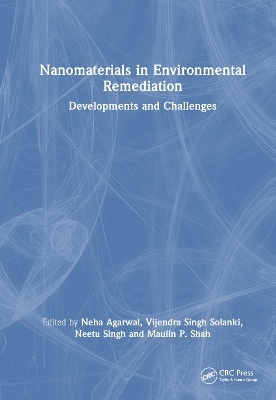
Nanomaterials in Environmental Remediation
CRC Press (Verlag)
978-1-032-77649-1 (ISBN)
- Noch nicht erschienen (ca. April 2025)
- Versandkostenfrei
- Auch auf Rechnung
- Artikel merken
Environmental contamination poses a significant threat to ecosystems and human health. Nanomaterials, with their unique properties and versatility, have emerged as promising tools for environmental remediation. This book collates recent studies and new developments in effective environmental remediation using nanomaterials for cleaning pollutants in different environmental matrices. It explores the role of carbon and composite nanomaterials, bio nanomaterials, nanosheets, and phytonanotechnology. It also delves into photocatalytic applications of nanomaterials, using 3D-printed materials for the remediation of the environment, along with a deep analysis of the potential environmental risks, challenges, and the responsible use of nanomaterials. The authors also cover the prospective application and advantages of engineered nanomaterials, emphasizing the continuous growth and potential metamorphic impact of nanotechnology.
Features
Provides a comprehensive review of the rapidly growing field of nanotechnology.
Includes in-depth discussion on the detection of pollutants with the help of nanomaterials.
Offers a critical insight into the synthesis and characterization of nanomaterials.
Covers a vast array of applications illustrating the wide use of different domains of nanotechnology along with their possible toxicological aspects.
Presents the future of green nanomaterials as sustainable solutions in environmental remediation.
This book is a great resource for researchers, academicians, students, and professionals in Environmental and Sustainable Engineering, Nanotechnology, and Environmental Remediation.
Dr. Neha Agarwal is an assistant professor in Department of Chemistry, Navyug Kanya Mahavidylaya, University of Lucknow, India. She completed her Ph.D. at the University of Lucknow. She is qualified in UGC-CSIR-NET Chemical Science and GATE-Chemical Science. She has published many research papers and review articles in Scopus Indexed journals. She has published 3 patents, and one has been granted among them. She has edited several books and authored one textbook for undergraduate students. Dr. Vijendra Singh Solanki is an assistant professor in the Department of Chemistry, Institute of Science and Research, IPS Academy, Indore, India. His Ph.D research was on degradation of tough dyes from wastewater for a sustainable environment. He has published many research papers on dyes degradation, nanoparticles synthesis, characterization, and applications with special focus on environmental applications. He has been granted many Indian patents. Dr. Neetu Singh is a state government employee (Group-A) and working as an assistant professor of Physics in Government Degree College, Uttar-Pradesh, India. She is also actively engaged in research work in Nanomaterials, Polymers, Polymer nanocomposites, metal oxides, Photocatalysis, and gas sensing and applications of nanomaterials. She has successfully completed her Ph.D. in Physics from University of Lucknow, Uttar Pradesh, India. She has published 14 research papers in international journals. Dr. Maulin P. Shah is Chief Scientist & Head of the Industrial Wastewater Research Lab, Division of Applied and Environmental Microbiology Lab at Enviro Technology Ltd., Ankleshwar, Gujarat, India. He received his Ph.D. in 2005 in Environmental Microbiology from Sardar Patel University, Vallabh Vidyanagar, Gujarat. His major work involves isolation, screening, identification, and genetic engineering of high impact of microbes for the degradation of hazardous materials. He has published more than 190 research papers in highly reputed national and international journals. He is an active Editorial Board Member in 110 highly reputed journals in the field of Environmental & Biological Sciences.
1. Delving into Nanomaterials: Fundamentals, Synthetic Techniques, Properties, Diverse Applications, and Recent Advancements. 2. An Introduction to Advanced Nanomaterials and Nanotechnology. 3. Bioinspired Green Synthesis of NMs. 4. Sustainable Nanomaterials: Synthesis and Characterization. 5. Nanomaterials in the Degradation of Toxic Organic Pollutants. 6. Advantages of Nanomaterials for Environmental Remediation. 7. Nanotechnology for Sustainable Environment. 8. Functionalized Nanomaterials: Properties to Perspective Applications in Environmental Remediation. 9. Carbon Nanomaterials for Remediation of Water Pollutants. 10. Nanosheet Composites for Wastewater Treatment: A Natural Biopolymer Approach. 11. Biocomposite Nanomaterials for Sustainable Environment. 12. Bio-Nanomaterials in Environmental Remediation. 13. Nanocomposites and Environmental Pollution Control. 14. Photocatalytic activity of Nanomaterials in Environmental Remediation. 15. 3D Printed Materials in Environmental Remediation. 16. Assessment of Potential Environmental Risks of Nano Remediation. 17. Opportunities and Challenges of Using Nanomaterials in the Remediation of Pollutants. 18. Benefits, Risks, and Responsible Use of Nanomaterials in Remediation. 19. dvancements in Nanoremediation: Sustaining the Natural Environment through Innovative Techniques. 20. Current Status and Future Prospects of Application of Engineered Nanomaterials.
| Erscheint lt. Verlag | 24.4.2025 |
|---|---|
| Zusatzinfo | 23 Tables, black and white; 51 Line drawings, color; 3 Line drawings, black and white; 19 Halftones, color; 70 Illustrations, color; 3 Illustrations, black and white |
| Verlagsort | London |
| Sprache | englisch |
| Maße | 178 x 254 mm |
| Themenwelt | Naturwissenschaften ► Biologie ► Biochemie |
| Technik ► Umwelttechnik / Biotechnologie | |
| ISBN-10 | 1-032-77649-8 / 1032776498 |
| ISBN-13 | 978-1-032-77649-1 / 9781032776491 |
| Zustand | Neuware |
| Haben Sie eine Frage zum Produkt? |
aus dem Bereich


